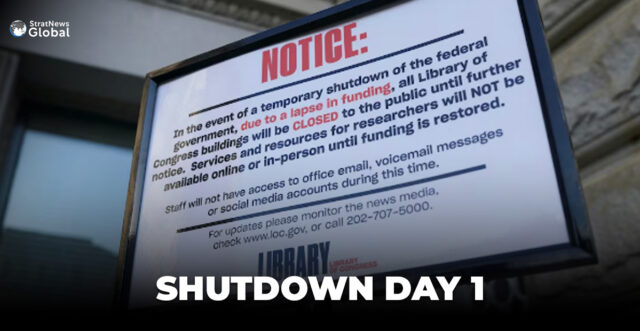The U.S. government has been forced into a partial shutdown after President Donald Trump’s Republican Party failed to reach an agreement with Democrats on a new spending bill, cutting off funding and leaving federal operations in limbo.
The shutdown, which began at 12:01 a.m. on Wednesday (04:01 GMT), is the first in nearly seven years and underscores the sharp divisions in Washington.
Although government shutdowns are a familiar feature of American politics, this one comes at a particularly volatile moment, as Trump pushes to shrink federal agencies and portrays the funding lapse as an opportunity to make permanent cuts.
Why Did The Shutdown Happen?
The shutdown stems from a failure of Republicans and Democrats to agree on funding beyond the end of the fiscal year. While Republicans control both chambers of Congress, the Senate’s rules require 60 votes to pass major spending legislation. That leaves Democrats with enough leverage to block a bill they oppose.
The core of the dispute lies in healthcare spending. Democrats have refused to support a Republican plan they argue would make it harder for Americans to access affordable healthcare. They are demanding an extension of tax credits—due to expire—that help millions of Americans pay for health insurance, as well as a reversal of cuts to Medicaid and health agencies enacted under Trump.
A stopgap funding bill passed the House of Representatives, but stalled in the Senate, where Democrats held firm. With neither side backing down, funding expired, and parts of the federal government were forced to shut their doors.
How Long Will The Shutdown Last?
The duration of the shutdown remains uncertain. In 2018, the last shutdown dragged on for 35 days, the longest in U.S. history, costing the economy billions and disrupting services nationwide.
Ending a shutdown requires compromise—something in short supply in Washington. Republicans could agree to extend healthcare subsidies, or Democrats might eventually yield to pressure if the disruption becomes severe. But so far, both camps are entrenched.
Trump and his advisers appear confident Democrats will shoulder the blame for withholding votes, while Democrats argue their defence of healthcare subsidies is popular with the public and energises their political base.
Impact On Services And Staff
A shutdown does not mean the entire government halts. Essential services, such as border protection, law enforcement, air traffic control, and in-hospital medical care, will continue—though employees in those sectors may be forced to work without pay until the impasse is resolved.
Social Security and Medicare checks will still go out, but benefit verification and card issuance could be delayed. Federal workers deemed “non-essential” will be placed on unpaid leave. Historically, furloughed workers have received back pay once shutdowns end, though uncertainty looms this time.
Every day, Americans could feel the effects in multiple ways. The Centres for Disease Control and Prevention (CDC) and the National Institutes of Health (NIH) are expected to halt many ongoing projects, jeopardising research and clinical trials. National parks may technically remain open, but without staff to manage them, vandalism and neglect are real risks, as seen during past shutdowns.
Air travel could face delays if flight systems slow down due to staff shortages, and passport applications may take longer to process. Museums, federal pre-schools, and food assistance programs are also likely to be curtailed.
The Congressional Budget Office (CBO) estimates that roughly 750,000 federal workers—around 40% of the workforce—could be placed on unpaid leave each day.
Trump’s Unorthodox Approach
Unlike previous presidents, Trump has openly embraced the shutdown as a political weapon. Rather than seeking a quick resolution, his administration has suggested the funding lapse could serve as a test of which government functions are “essential” and which could be eliminated permanently.
“We’ll be laying off a lot of people,” Trump declared earlier this week, signalling a willingness to go beyond temporary furloughs.
Over the past nine months, Trump has already cut back spending and scaled down the federal workforce. This shutdown, some analysts argue, could accelerate those efforts, turning what has historically been a temporary disruption into an opportunity for structural downsizing.
History Of Government Shutdowns
Government shutdowns have become a recurring feature of modern U.S. politics. Trump himself presided over three during his first term, including the record-breaking 35-day standoff in late 2018 over funding for a border wall with Mexico. That shutdown ended after mass sick calls from unpaid air traffic controllers disrupted flights nationwide, forcing lawmakers back to the table.
Other presidents have also grappled with shutdowns. Bill Clinton endured a 21-day shutdown in 1995, Barack Obama faced a 16-day one in 2013, and Ronald Reagan oversaw eight shorter shutdowns in the 1980s.
Unlike many other democracies, where a budget vote is tied directly to the government’s survival, the U.S. system requires both Congress and the White House to agree on spending bills. This separation of powers, combined with partisan divides, often makes deadlock more likely.
Economic Fallout
The full economic impact of the current shutdown will hinge on its length. Analysts estimate that each week of government closure could shave 0.1 to 0.2 percentage points off economic growth, though much of that might be recouped once federal workers are paid and delayed spending resumes.
The 2018-2019 shutdown cost the economy an estimated $11 billion, with $3 billion in losses never recovered. This time, the stakes could be higher. Trump’s threats to fire workers outright, rather than furlough them, suggest some losses could be permanent.
The shutdown also injects uncertainty into an economy already rattled by trade disputes, artificial intelligence disruptions, and fluctuating markets. The likely delay of crucial government reports, such as monthly jobs data, could further unsettle investors and businesses.
What Comes Next?
For now, Washington remains at a standstill. Democrats are betting that public opinion will side with their push to protect healthcare subsidies, while Republicans hope frustration over closed services will push voters to blame the opposition.
But for the hundreds of thousands of federal workers facing missed paychecks, and for the millions of Americans who depend on government services, the political stalemate has already become a personal crisis.
(With inputs from IBNS)





